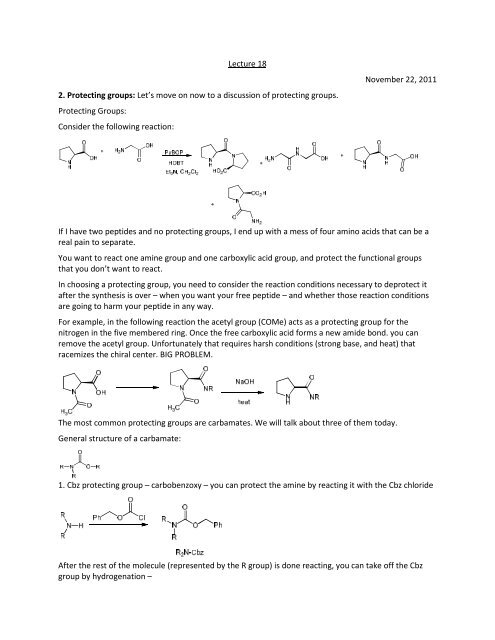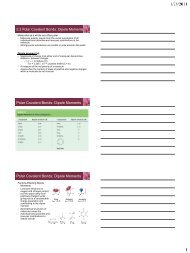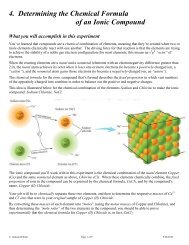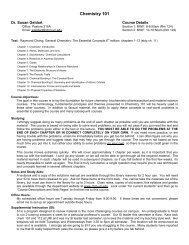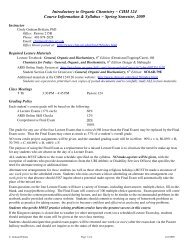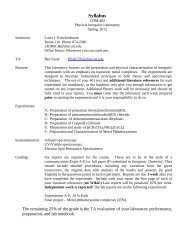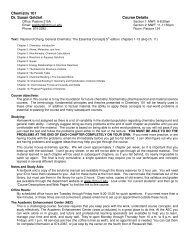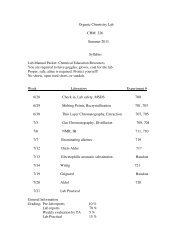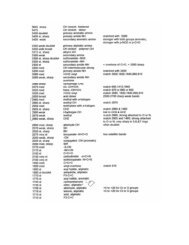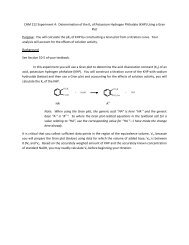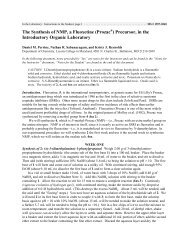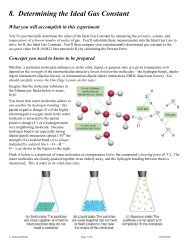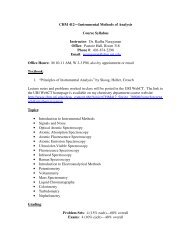2. Protecting groups - URI Department of Chemistry
2. Protecting groups - URI Department of Chemistry
2. Protecting groups - URI Department of Chemistry
You also want an ePaper? Increase the reach of your titles
YUMPU automatically turns print PDFs into web optimized ePapers that Google loves.
Lecture 18<strong>2.</strong> <strong>Protecting</strong> <strong>groups</strong>: Let’s move on now to a discussion <strong>of</strong> protecting <strong>groups</strong>.<strong>Protecting</strong> Groups:Consider the following reaction:November 22, 2011If I have two peptides and no protecting <strong>groups</strong>, I end up with a mess <strong>of</strong> four amino acids that can be areal pain to separate.You want to react one amine group and one carboxylic acid group, and protect the functional <strong>groups</strong>that you don’t want to react.In choosing a protecting group, you need to consider the reaction conditions necessary to deprotect itafter the synthesis is over – when you want your free peptide – and whether those reaction conditionsare going to harm your peptide in any way.For example, in the following reaction the acetyl group (COMe) acts as a protecting group for thenitrogen in the five membered ring. Once the free carboxylic acid forms a new amide bond. you canremove the acetyl group. Unfortunately that requires harsh conditions (strong base, and heat) thatracemizes the chiral center. BIG PROBLEM.The most common protecting <strong>groups</strong> are carbamates. We will talk about three <strong>of</strong> them today.General structure <strong>of</strong> a carbamate:1. Cbz protecting group – carbobenzoxy – you can protect the amine by reacting it with the Cbz chlorideAfter the rest <strong>of</strong> the molecule (represented by the R group) is done reacting, you can take <strong>of</strong>f the Cbzgroup by hydrogenation –
This is a useful protecting group because the side products (carbon dioxide, toluene) are so easilyseparable.<strong>2.</strong> Boc protecting group – you protect the amine by reacting it with Boc-anhydride:And when it’s done reacting, the Boc group is removed with trifluoroacetic acid (TFA) (relatively strongacid):Mechanism <strong>of</strong> deprotection:3. F-moc protecting group – abbreviation for 9-fluoromethoxycarbonylThe free amine is protected by reacting with Fmoc-chloride or Fmoc-OSU:The mechanism for F-moc protection is pretty straightforward:Nucleophilic attack <strong>of</strong> the amino group, followed by displacement <strong>of</strong> the succinimide leaving group, togenerate a protected amino acid.Fmoc is deprotected by treating it with a secondary amine base like piperidine.
The mechanism <strong>of</strong> F-moc deprotection is shown below:The base attacks the fluorenyl proton – this proton is slightly acidic because when you form the anion,that negative charge can be stabilized by the entire aromatic system. The anion then kicks <strong>of</strong>f thecarbamate, which decomposes to lose carbon dioxide and form the desired free amine product.So that concludes the protecting <strong>groups</strong> for amines. The carboxylic acid also needs to be protected (if itis not the part <strong>of</strong> the amino acid that you want to react). This is typically done with a tert-butyl ester (oranother mild ester).Let’s take a sample peptide and think about how to synthesize it both retrosynthetically and in theforward direction.Retrosynthesis:Forward direction:
The first step is to figure out what amino acids this is made from, by disconnecting at the amide bond:And now we can do the forward direction:FmocHNOOH+ H 2 NCH 3OOEDCFmocHNO CH 3ONHOTFAFmocHNO CH 3OHNHONHHNCbzHNCbzCbzH 2 NCO 2 MeCO 2 MeFmocHNO CH 3HNNHOCO 2 MeCO 2 MeHNNH(Fmoc deprotection)Pd/C(Cbz deprotection)NaOH, 0 o C(methyl ester deprotection)HNCbzH 2 NO CH 3HNNHOCO 2 HCO 2 HNH 2We are going to continue our peptide discussion next time. I will post a problem set on peptidechemistry, as well as an opportunity for you to earn a little bit <strong>of</strong> extra credit in this class.


